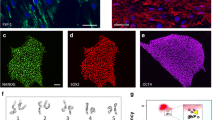Abstract
Inherited retinal diseases (IRDs) are a diverse group of rare eye disorders, resulting in vision loss or blindness. The underlying reason is mutation in one or more than 250 different genes associated with the development and normal physiology of retina largely comprising of rod/cone photoreceptors and retinal pigment epithelium. Interestingly, the sub retinal region of an eye has been shown to be immune privileged, broadening the scope of cell-replacement therapies for patients suffering from retinal degeneration. Several groups around the globe, including ours, have demonstrated safety and efficacy in preclinical studies by employing various approaches of retinal cell therapy. This had largely been possible with the advent of induced pluripotent stem cells (iPSC)—reprogrammed from adult somatic cells, that serves as a starting material for generating retinal cells de novo. Here, we describe a detailed procedure for reprogramming peripheral blood mononuclear cells (PBMC) into iPSC using episomal vectors without any physical disruption in the host genome. The lines thus created were tested for sterility, cytogenetic stability, identity, absence of episomal plasmids and further authenticated for pluripotency and tri-lineage differentiation capacity by embryoid body formation and immunocytochemistry. We believe that this feeder-cell free, animal-product free and gene-insertion free protocol would help people to develop and bank patient-specific cell lines for autologous cell therapies for incurable rare diseases.
Access this chapter
Tax calculation will be finalised at checkout
Purchases are for personal use only
Similar content being viewed by others
References
Thomson JA, Itskovitz-Eldor J, Shapiro SS et al (1998) Embryonic stem cell lines derived from human blastocysts. Science 282(5391):1145–1147
Ouyang H, Goldberg JL, Shuyi Chen S et al (2016) Ocular stem cell research from basic science to clinical application: a report from Zhongshan ophthalmic center ocular stem cell symposium. Int J Mol Sci 17(3):415
Takahashi K, Tanabe K, Ohnuki M et al (2007) Induction of pluripotent stem cells from adult human fibroblasts by defined factors. Cell 131(5):861–872
World Health Organization (WHO) Blindness and vision impairment prevention. Available from https://www.who.int/blindness/causes/priority/en/index1.html
Levin LA, Ritch R, Richards JE, Borrás T (2004) Stem cell therapy for ocular disorders. Arch Ophthalmol 122(4):621–627
Hokayem JE, Cukier HN, Dykxhoorn DM (2016) Blood derived induced pluripotent stem cells (iPSCs): benefits, challenges and the road ahead. J Alzheimers Dis Parkinsonism 6(5):27
Bang JS, Choi NY, Lee M et al (2018) Optimization of episomal reprogramming for generation of human induced pluripotent stem cells from fibroblasts. Anim Cells Syst (Seoul) 22(2):132–139
Konala VBR, Nandakumar S, Battu R et al (2020) Derivation of three induced pluripotent stem cell lines under feeder-free culture conditions from peripheral blood mononuclear cells (PBMC) of Indian patients suffering from inherited retinal diseases carrying different mutations. Stem Cell Res 45:101757
Acknowledgments
The authors thank Dr. Odity Mukherjee, National Centre for Biological Sciences (TIFR) for helpful advice during reprogramming and sharing the Addgene plasmids. Dr. Shagufta Praveen from Manipal Institute of Regenerative Medicine is acknowledged for technical support. Eyestem and Centre for Cellular and Molecular Platforms (C-CAMP) is acknowledged for funding and infrastructure respectively.
Author information
Authors and Affiliations
Corresponding author
Editor information
Editors and Affiliations
Rights and permissions
Copyright information
© 2021 Springer Science+Business Media, LLC
About this protocol
Cite this protocol
Konala, V.B.R., Nandakumar, S., Surendran, H., Pal, R. (2021). Derivation of Induced Pluripotent Stem Cell (iPSC) Lines from Patient-Specific Peripheral Blood Mononuclear Cells (PBMC) Using Episomal Vectors. In: Turksen, K. (eds) Induced Pluripotent Stem Cells and Human Disease. Methods in Molecular Biology, vol 2549. Humana, New York, NY. https://doi.org/10.1007/7651_2021_385
Download citation
DOI: https://doi.org/10.1007/7651_2021_385
Published:
Publisher Name: Humana, New York, NY
Print ISBN: 978-1-0716-2584-2
Online ISBN: 978-1-0716-2585-9
eBook Packages: Springer Protocols




